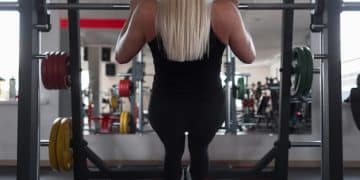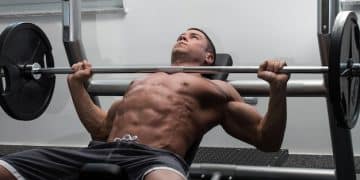Avoid These 3 Common Squat Mistakes Killing Your Gains
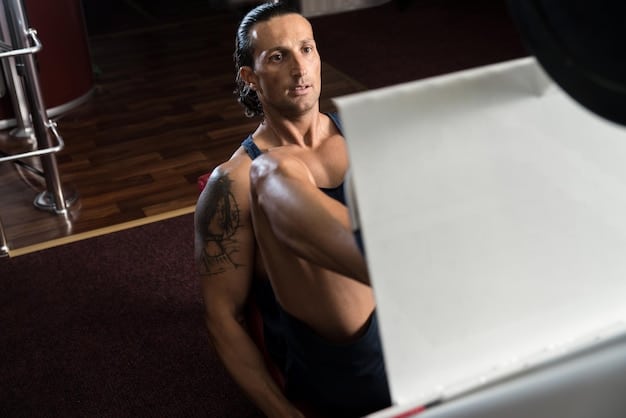
Squats are foundational for strength and muscle growth, yet common mistakes like improper depth, knee valgus, and poor bar path significantly hinder progress and increase injury risk, demanding precise technique to maximize gains.
In the world of strength training, the squat reigns supreme as a cornerstone exercise, an undisputed king for building lower body power, muscle, and athleticism. However, many lifters inadvertently commit common errors that sabotage their progress and even risk injury. This article will help you identify and **avoid these 3 common squat mistakes that are killing your gains** to ensure your efforts translate into tangible results.
The foundational role of the squat in strength training
The squat is often hailed as the “king of exercises” for good reason. It’s a compound movement that recruits multiple muscle groups simultaneously, leading to significant strength gains, muscle hypertrophy, and improved overall athleticism. From competitive powerlifters to weekend warriors, the squat holds a central place in virtually every effective training regimen.
Its complexity, however, means there’s a fine line between executing a perfect squat that yields immense benefits and one that leads to stagnation, frustration, or even injury. Understanding the mechanics involved, the muscles engaged, and the common pitfalls is crucial for anyone serious about optimizing their training. A well-executed squat can transform your physique and performance, while a poorly executed one can undermine your entire lifting journey. It’s about more than just moving weight; it’s about moving it correctly and efficiently.
Muscles engaged: A symphony of power
The squat is a full-body movement, but it primarily targets the major muscle groups of the lower body and core. When performed correctly, it’s a powerful stimulus for growth and strength. Understanding which muscles are working can help you identify if a part of your kinetic chain is weak or not engaging properly, which often contributes to squat mistakes.
- Quadriceps: These large muscles on the front of your thigh are responsible for knee extension, playing a crucial role in standing up from the squat’s bottom position.
- Glutes: Comprising the gluteus maximus, medius, and minimus, these muscles are vital for hip extension and external rotation, especially at the top of the squat.
- Hamstrings: While primarily hip extensors, the hamstrings also act as knee flexors and stabilizers, supporting the movement.
- Adductors: The inner thigh muscles assist in stabilizing the hips and providing power during the concentric phase.
- Core (Abs and Lower Back): An engaged core is non-negotiable for maintaining spinal rigidity and preventing injury throughout the lift.
Beyond muscle: Systemic benefits
The impact of squats extends beyond just building muscle. Regularly incorporating proper squats into your routine can lead to a cascade of systemic benefits. These advantages underscore why mastering this exercise is so important for holistic fitness development. It’s not just about what you see in the mirror; it’s about how your entire body functions.
A strong squat often translates to better performance in other lifts and daily activities. It improves bone density, strengthens connective tissues, and enhances overall athletic output, crucial for sports and movements requiring explosive lower body power. The metabolic demand of squats also contributes to increased calorie expenditure and fat loss.
Mistake 1: Insufficient squat depth
One of the most frequently observed and detrimental squat mistakes is not going deep enough. Many lifters, for various reasons, cut their squats short, failing to reach the crucial depth where the hips descend below the knees. This partial range of motion (ROM) severely limits muscle activation, particularly in the glutes and hamstrings, ultimately stifling gains.
When you perform a shallow squat, you’re primarily engaging your quadriceps, essentially turning the movement into a leg press. While quads are essential, neglecting the full posterior chain means you’re missing out on significant strength and muscle development. The partial rep might allow you to lift more weight, but it’s a false sense of progress, as you’re not fully taxing the intended muscle groups or benefiting from the full physiological advantages of the movement.
Why depth matters for muscle activation and strength
Optimal squat depth ensures that all major lower body muscles, especially the glutes and hamstrings, are fully recruited. Studies consistently show that greater depth leads to superior muscle activation and, over time, more significant strength and hypertrophy gains in the posterior chain. When your hips drop below your knees, the stretch on the glutes and hamstrings is maximized, allowing for a more powerful contraction on the way up.
Beyond muscle activation, full depth contributes to joint health and mobility. Regularly squatting to proper depth helps maintain and improve hip and ankle mobility, reducing the risk of imbalances and potential injuries in the long run. It’s about building a robust, resilient body, not just lifting heavy weights for ego.
Common reasons for shallow squats
Several factors contribute to individuals cutting their squats short. Identifying these underlying issues is the first step toward correcting them. Addressing these root causes is far more effective than simply trying to force depth, which can compromise form and lead to injury. Sometimes, it’s a matter of perception, thinking one is deep enough when they are not.
- Mobility limitations: Tight hips, ankles, or glutes can physically restrict the ability to reach full depth while maintaining proper form.
- Lack of strength: The bottom position of the squat is often the weakest point for many individuals. Fear of not being able to stand back up can lead to prematurely ending the descent.
- Poor motor control: Some lifters haven’t developed the coordination or proprioception to feel and maintain proper depth through the entire movement.
- Ego lifting: Trying to lift too much weight often results in compromised form, with depth being one of the first casualties.
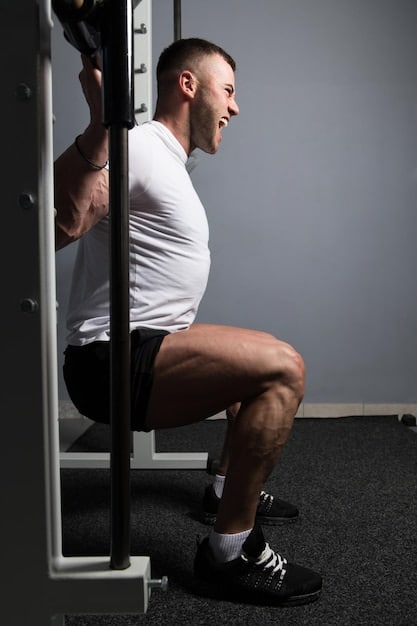
How to achieve proper depth
Correcting insufficient depth requires a multifaceted approach, addressing mobility, strength, and technique. Consistency is key, as improving depth is often a gradual process. It’s also crucial to prioritize form over weight until proper depth is consistently achieved.
Start by practicing bodyweight squats, focusing on sinking as low as possible while keeping your heels on the ground and your chest up. Incorporate mobility drills for the ankles and hips regularly. Consider using a box or bench to squat to as a depth target, gradually lowering the height over time. If strength at depth is an issue, paused squats (pausing at the bottom for 1-3 seconds) can help build strength and confidence in that position. Reducing the weight and focusing purely on form will always be the most effective strategy.
Mistake 2: Allowing knees to cave inward (Valgus Collapse)
Another pervasive and potentially injurious squat mistake is letting the knees collapse inward, a phenomenon known as valgus collapse or knee valgus. This often occurs during the ascent phase of the squat, particularly when lifters are pushing heavy weights or lack proper motor control. Beyond being visually unappealing, knee valgus places immense stress on the knee joint and surrounding ligaments, significantly increasing the risk of injuries like ACL tears, patellofemoral pain syndrome, and meniscal damage.
This inward movement of the knees indicates a weakness or lack of activation in the gluteal muscles, particularly the gluteus medius, which are responsible for externally rotating the femur and keeping the knees tracking outward over the toes. When these muscles fail to engage properly, other, less suitable structures are forced to compensate, leading to instability around the knee joint.
The mechanics of knee valgus and risk factors
Knee valgus is a complex kinematic chain issue, not just a standalone problem. It often stems from a combination of muscular imbalances, mobility restrictions, and suboptimal motor patterns. Understanding the underlying mechanisms is crucial for effective remediation. It’s a sign that something is amiss higher up or lower down the kinetic chain.
When the glutes aren’t powerful enough to maintain hip abduction and external rotation, the knees compensationally drift inward. This internal rotation of the femur puts excessive strain on the medial (inner) structures of the knee. Other contributing factors can include excessive pronation of the feet (flat feet), tight adductors, or a general lack of awareness of proper knee alignment during the lift.
Identifying the causes of knee valgus
Several issues can contribute to knee valgus. A comprehensive assessment, perhaps by a qualified coach or physical therapist, can pinpoint the exact causes for an individual. It’s rarely a single factor but rather a combination that creates the perfect storm for this compensation pattern.
- Weak glute medius and minimus: These abductor muscles are critical for stabilizing the hips and preventing internal rotation of the femur.
- Tight adductors: Overly tight inner thigh muscles can pull the knees inward.
- Ankle immobility: Limited dorsiflexion can force the knees to compensate by collapsing inward to achieve depth.
- Foot pronation: An arch that collapses inward can lead to a chain reaction up the leg, encouraging knee valgus.
- Muscle recruitment issues: Even with strong glutes, some individuals may have difficulty simply activating them during the squat.
Correcting knee valgus: Strategies and drills
Rehabbing knee valgus involves strengthening the weak links and reinforcing proper movement patterns. This often requires a conscious effort to ‘think’ about knee position throughout the movement. It’s a process of re-educating the body. Start with lighter weights and build the habit.
Incorporate glute activation exercises into your warm-up, such as clam shells, band walks, and glute bridges. During the squat itself, place a resistance band just above your knees and actively push your knees out against the band throughout the entire movement. This provides immediate feedback and helps activate the correct muscles. Focus on cueing yourself to “push your knees out” or “spread the floor with your feet.” Strengthening the glutes and improving hip mobility are paramount for long-term correction.
Mistake 3: Inconsistent bar path or “Good Morning” squat
The third common squat mistake to avoid is an inconsistent bar path, particularly the dreaded “good morning” squat. In a properly executed back squat, the barbell should travel in a relatively straight vertical line over the middle of your foot. Any significant deviation, especially the hips rising much faster than the chest, indicates a “good morning” squat, where the movement devolves into a hip hinge rather than a balanced squat.
This error puts excessive strain on the lower back, turning a full-body leg exercise into a lower back extension, increasing the risk of disc herniation or other spinal injuries. It also reduces the effectiveness of the squat for building leg and glute strength, as the emphasis shifts away from the quadriceps and glutes and onto the hamstrings and lower back in an inefficient manner. It’s a sign that your balance and strength distribution are off.
Understanding proper bar path and its importance
An ideal bar path is a straight vertical line, or a very slight ‘J’ curve, that stays directly over the mid-foot from the top of the lift to the bottom and back up. This ensures that the weight is distributed evenly, and all muscle groups are engaged proportionately. A consistent bar path is a hallmark of an efficient and safe squat.
When the bar path deviates significantly forward or backward, it creates unwanted leverage issues, increasing the mechanical disadvantage for certain muscle groups and placing undue stress on joints. A forward bar path, often seen in the “good morning” squat, means the hips are shooting up too quickly, leaving the torso to follow, turning the lift into a precarious back extension.
Causes of an inconsistent bar path
Several factors can contribute to an inconsistent bar path, often rooted in strength imbalances or technical flaws. Identifying these causes is the first step toward achieving a more efficient and safer squat. Sometimes, it’s a simple lack of awareness of the bar’s trajectory.
- Weak core: An inability to maintain a rigid torso throughout the lift can lead to the chest falling forward and the hips shooting back.
- Weak quadriceps: If the quads are the weakest link, the body will compensate by shifting the load to the stronger glutes and hamstrings, causing the hips to rise prematurely.
- Poor bracing technique: Insufficient intra-abdominal pressure leads to a loss of spinal rigidity, making it difficult to maintain an upright torso.
- Starting too far over the bar: If the bar is not properly aligned over the mid-foot at the start, it will be difficult to maintain a vertical path.
- Incorrect bar placement: High bar versus low bar placement can affect the torso lean, but an inconsistent path often means the wrong leverage is being used.
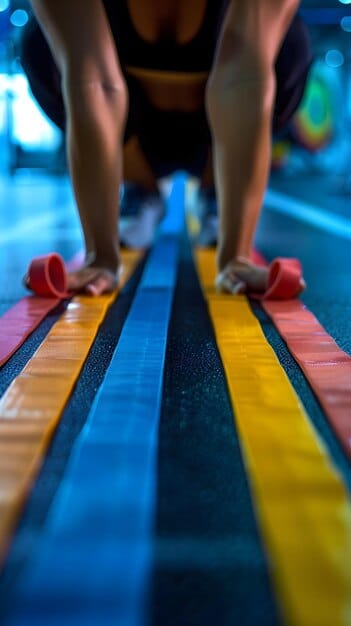
Fixing the good morning squat and refining bar path
Correcting an inconsistent bar path, particularly the “good Morning” squat, requires a focus on core strength, quad engagement, and conscious control over the torso and hip movement. It usually means slowing down the lift and really feeling the movement. Filming yourself can provide invaluable feedback.
Practice the concept of “sitting down between your knees” rather than “sitting back.” Focus on maintaining a consistent torso angle relative to your shins throughout the descent and ascent. Strengthen your core with exercises like planks, dead bugs, and bird-dogs. Incorporate front squats or pause squats to build quadriceps strength and improve your ability to stay upright. Reduce the weight and prioritize keeping your chest up and the bar directly over your mid-foot. The goal is a balanced, simultaneous rise of both hips and shoulders.
Beyond the big three: Additional tips for squat mastery
While addressing the three common mistakes of insufficient depth, knee valgus, and inconsistent bar path is paramount, achieving true squat mastery involves refining various other elements of your technique and approach. These additional tips can provide further support and help you unlock your full squatting potential. It’s about building a holistic understanding of the movement.
Foot stance and toe angle: Finding your foundation
Your foot stance and toe angle significantly influence your ability to squat comfortably and effectively. There’s no one-size-fits-all answer, as individual anatomy plays a crucial role. Experiment to find what works best for you. This foundational element impacts everything from depth to knee tracking.
Generally, a stance slightly wider than shoulder-width, with toes pointed slightly outward (around 15-30 degrees), allows for optimal hip mobility and knee tracking. However, some individuals might prefer a narrower or wider stance based on their hip structure. The key is to find a position where you can go deep comfortably while keeping your knees tracking over your toes.
Breathing and bracing: The overlooked core of a great squat
Proper breathing and bracing are arguably the most critical components for spinal safety and maximizing strength in any heavy compound lift, especially the squat. Many lifters overlook this aspect, but it’s the foundation of a stable and powerful movement. It provides the internal support necessary to lift heavy loads.
Before each rep, take a deep breath into your belly (not your chest), expanding your abdomen in all directions. Then, brace your core as if you’re preparing to take a punch. This technique, known as the Valsalva maneuver, creates intra-abdominal pressure, which stabilizes your spine and allows you to transfer force more efficiently from your legs to the barbell. Practice this diligently; it’s a game-changer.
Warm-up and mobility drills: Preparing for performance
A comprehensive warm-up isn’t just about getting your heart rate up; it’s about preparing your body for the specific demands of the squat. Incorporating dynamic stretches and mobility drills targeting the hips, ankles, and upper back can significantly improve your squat mechanics and reduce injury risk. Ignoring this can severely limit your depth and form.
Spend 5-10 minutes on light cardio, followed by dynamic stretches like leg swings, hip circles, and cat-cows. Dedicate specific time to ankle dorsiflexion mobility (e.g., wall stretches) and hip internal/external rotation drills. Activating the glutes with exercises like clam shells or resistance band walks before loading the bar will also set you up for success.
Programming your squats for continuous progress
Mastering squat technique is one thing; programming them effectively for continuous gains is another. Your training methodology should align with your goals, whether it’s strength, hypertrophy, or endurance. Smart programming ensures that the effort you put into perfecting your form translates into consistent progression. It’s about more than just showing up; it’s about strategic planning.
Volume, intensity, and frequency: Finding the right balance
The variables of volume (sets x reps), intensity (weight lifted), and frequency (how often you squat) must be balanced to elicit adaptations without overtraining. For strength, lower reps and higher intensity might be preferred. For hypertrophy, moderate reps and volume often work best.
Beginners might benefit from higher frequency (2-3 times per week) with moderate volume and intensity to practice technique. Intermediate lifters might vary intensity throughout the week (e.g., one heavy day, one higher volume day). Always listen to your body and incorporate deload weeks as needed to facilitate recovery and prevent burnout.
Progressive overload: The engine of growth
Regardless of your specific goals, the principle of progressive overload is essential for long-term gains. This means continually challenging your body beyond its current capacities. Without it, your progress will inevitably stall. There are multiple ways to apply progressive overload:
- Increase the weight: The most straightforward method, adding a small amount of weight to the bar over time.
- Increase reps: Perform more repetitions with the same weight.
- Increase sets: Add additional sets for the same weight and reps.
- Decrease rest time: Shorter rest periods between sets can increase the metabolic demand.
- Improve technique: While not a direct overload in weight, refining technique allows you to lift the same weight more efficiently, setting you up for heavier loads later.
- Increase frequency: Squatting more often can contribute to overall volume.
Listening to your body: Recovery and periodization
Consistency is crucial, but so is recovery. Overtraining can lead to plateaus, burnout, and increased injury risk. Incorporate deloads or active recovery sessions regularly. Periodization, or varying your training over time, can also prevent adaptation plateaus and optimize performance for specific goals.
Pay attention to signs of overtraining, such as persistent fatigue, decreased performance, joint pain, or irritability. Ensure adequate sleep, nutrition, and stress management. Integrating lighter weeks or complete breaks strategically allows your body to recover, adapt, and come back stronger.
When to seek expert guidance
While this guide provides comprehensive advice on avoiding common squat mistakes, some individuals may benefit from professional guidance. Personal trainers, strength coaches, or physical therapists can offer personalized assessments and corrections, especially if you’re struggling with persistent issues or pain.
They can identify subtle technical flaws, address specific mobility limitations through targeted drills, and design a progressive program tailored to your unique needs and goals. An objective eye is often invaluable, as it can spot things you might miss in your own form. Don’t hesitate to invest in expert eyes if you’re serious about long-term progress and injury prevention.
Regular feedback from a knowledgeable coach can make a significant difference in accelerating your progress and ensuring that you are lifting safely and effectively. They can also help you navigate through plateaus and modify your training as your body adapts and strengthens.
| Key Mistake | Brief Solution |
|---|---|
| ⬇️ Insufficient Depth | Prioritize mobility drills for hips and ankles; reduce weight to practice full range of motion. |
| 🦵 Valgus Collapse | Strengthen glute medius with band work; actively push knees out over toes. |
| ↗️ Inconsistent Bar Path | Focus on core bracing; keep chest up; practice front squats or pause squats for quad strength. |
Frequently asked questions (FAQ)
▼
Ankle mobility is crucial for squat depth. Perform ankle dorsiflexion drills like wall stretches, kneeling dorsiflexion, and banded ankle mobilizations regularly. Foam rolling your calves can also help release tightness. Consider investing in lifting shoes with elevated heels if mobility is a significant limiting factor and not quickly improving.
▼
Yes, for many people, especially those with longer femurs, it is perfectly normal and often necessary for the knees to go past the toes to achieve proper depth while maintaining balance. The key is that the knees track directly over the toes and do not collapse inward. Focus on balance and keeping your heels grounded, not an arbitrary toe line.
▼
A good squat warm-up involves light cardio (5 min), dynamic stretches (leg swings, hip circles), mobility drills (ankle dorsiflexion, cat-cow), and glute activation exercises (banded clam shells, glute bridges). Finish with progressively heavier sets of squats with just the bar, focusing intently on form, preparing for your working sets.
▼
For most individuals, squatting 2-3 times per week is an effective frequency for seeing consistent improvements. This allows for sufficient practice and muscle stimulus while providing enough recovery time. Beginners might benefit from higher frequency to really reinforce the movement pattern, while advanced lifters may vary based on specific programming.
▼
Squatting itself typically does not cause knee pain if proper form is maintained. However, common issues like knee valgus, insufficient depth, or excessive loading with poor technique can definitely contribute to knee pain. Overtraining without adequate recovery can also lead to joint fatigue. Prioritize form, listen to your body, and ensure progressive overload is managed.
Conclusion
Mastering the squat is a journey of continuous refinement, but by actively working to **avoid these 3 common squat mistakes that are killing your gains** – insufficient depth, knee valgus, and inconsistent bar path – you lay a solid foundation for sustainable progress. It’s about prioritizing perfect form over personal bests, building a resilient body, and recognizing that quality reps always trump quantity. Embrace the process, be patient, and the king of exercises will undoubtedly reward your dedication with unparalleled strength, muscle, and a robust physique.
